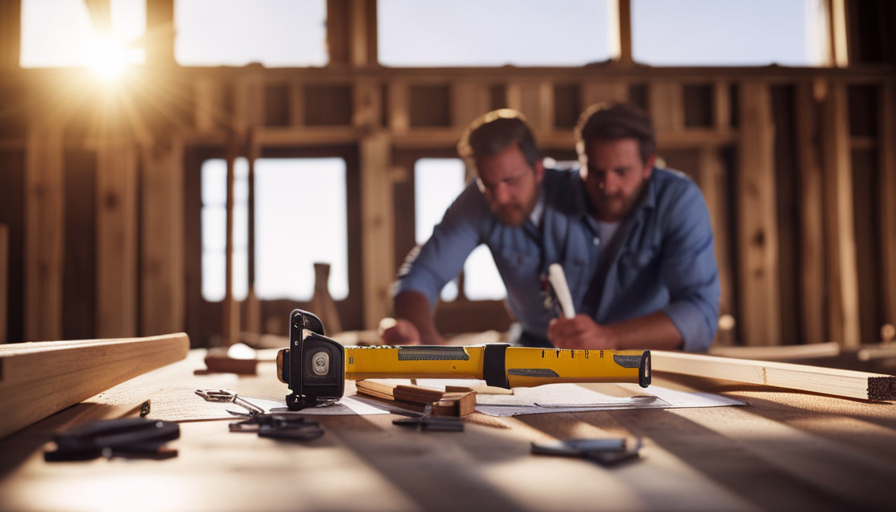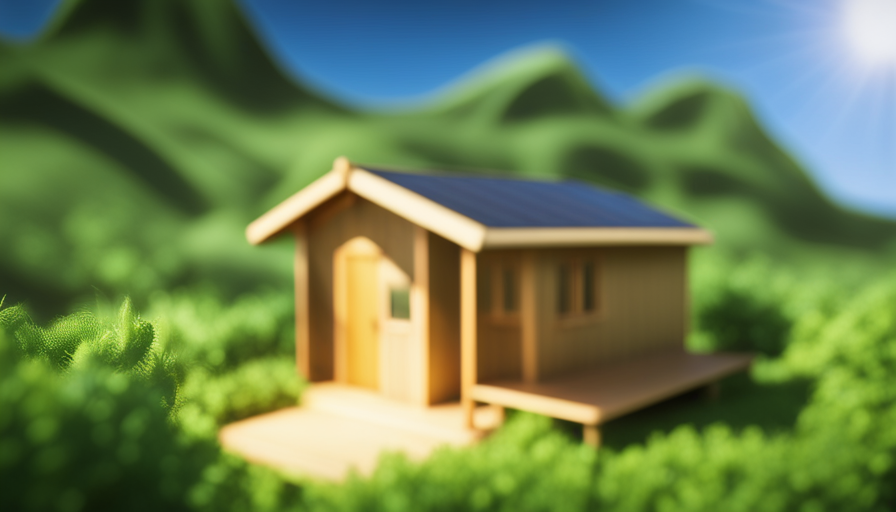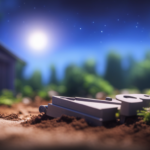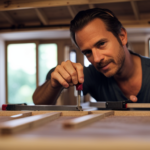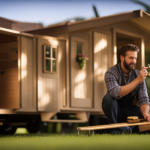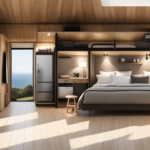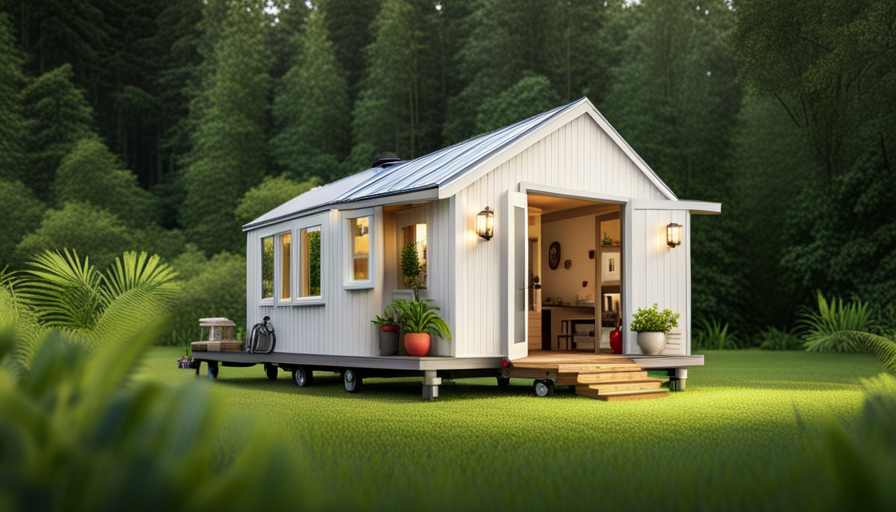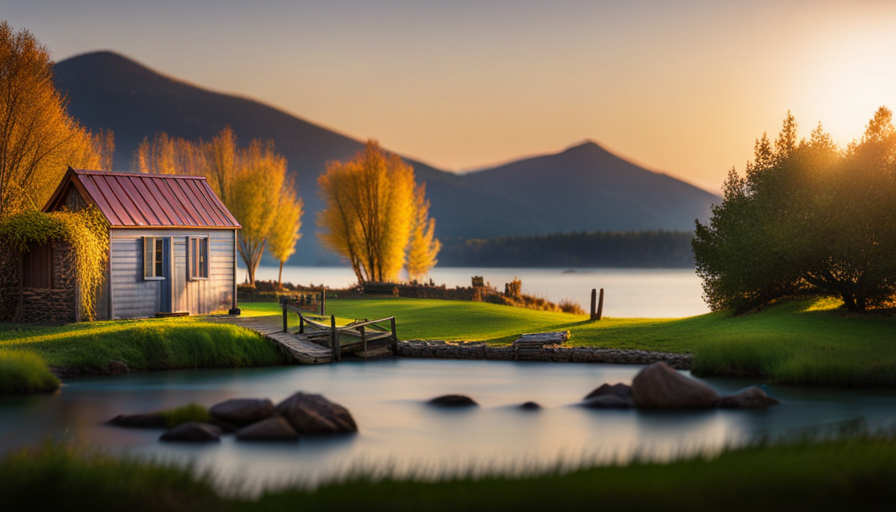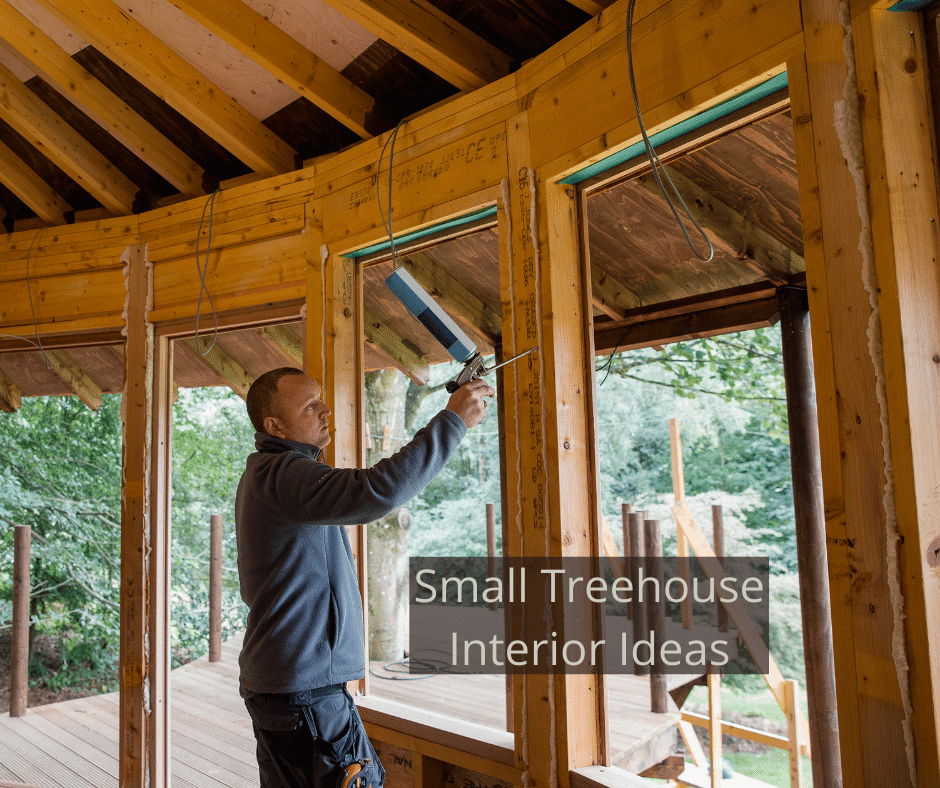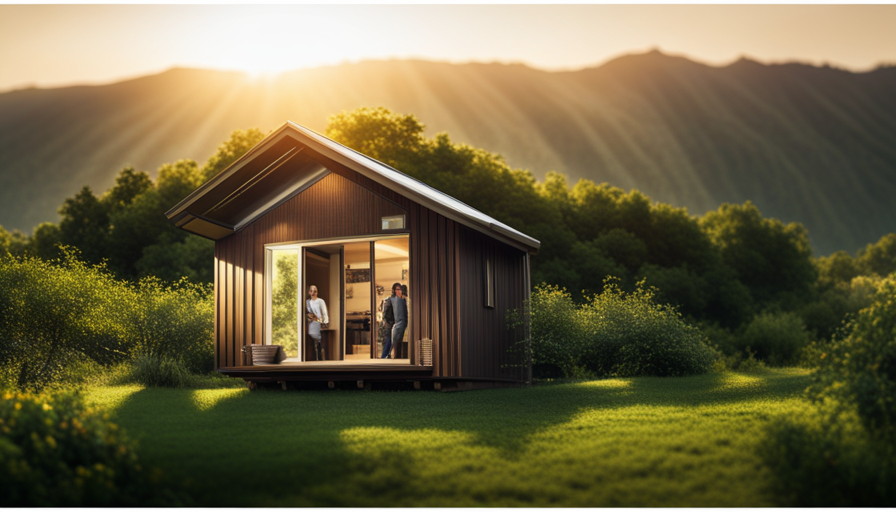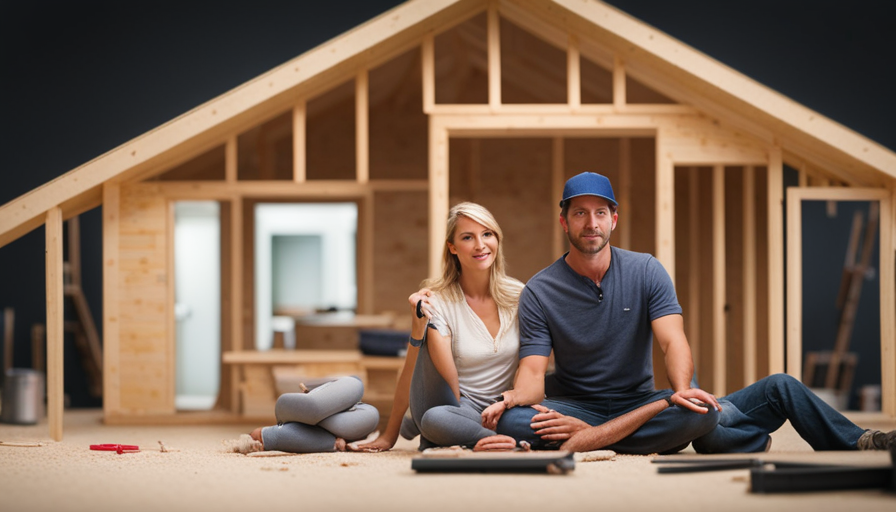Have you ever considered escaping traditional living spaces to embrace a minimalist lifestyle? If so, building a tiny house might be the perfect solution for you.
Picture this: a cozy, compact dwelling that is uniquely tailored to your needs and preferences. A haven of simplicity and functionality, where every square inch is maximized for efficiency.
In this article, I will guide you through the process of constructing your very own tiny house, step by step. From determining your needs and goals, to obtaining permits and gathering materials, to finalizing the finishing touches, I will provide you with the technical know-how and precise instructions you need to bring your vision to life.
So, if you’re ready to embark on this rewarding journey, let’s dive in and explore the world of tiny house construction together.
Key Takeaways
- Determine needs and goals, prioritize factors like size, layout, and functionality.
- Thoroughly research and explore design options and styles, incorporating space optimization techniques and sustainable building materials.
- Obtain necessary permits and navigate zoning regulations and building codes.
- Maximize space utilization with clever storage solutions and multifunctional furniture, and personalize the tiny house with artwork, photographs, plants, and textiles.
Determine Your Needs and Goals
You’ll need to envision your ideal tiny house and clarify your goals before you can start building it. Determining your priorities and setting objectives will help guide you through the process and ensure that you create a space that meets your needs.
Start by thinking about what you want to achieve with your tiny house. Are you looking for a minimalistic lifestyle, a sustainable living option, or simply a cozy retreat? Once you have a clear vision, prioritize your needs. Consider factors such as size, layout, and functionality. Do you need a separate workspace, a full kitchen, or multiple bedrooms? Make a list of your must-haves and nice-to-haves to help you make decisions later on.
Next, set specific objectives for your tiny house project. Think about your timeline, budget, and resources. How long are you willing to spend on building your tiny house? How much money can you allocate for the project? Do you have any construction skills or will you need to hire professionals? Answering these questions will give you a clearer understanding of what you need to accomplish.
Transitioning into the subsequent section about research and design, it’s important to conduct thorough research to gather ideas and inspiration for your tiny house. By exploring various design options and learning from others’ experiences, you can refine your goals and make informed decisions for your own project.
Research and Design
To effectively research and design my tiny house, I need to explore different styles and layouts available. This will help me determine the best design that meets my needs and preferences.
Once I’ve chosen a style, I’ll create a detailed floor plan and construction plan to ensure that every aspect of the house is meticulously planned and executed.
Explore different tiny house styles and layouts
When considering the layout of your tiny house, it’s fascinating to note that studies have shown that open floor plans can create a sense of spaciousness, making your small space feel much larger than it actually is.
Tiny house design tips include exploring different styles and layouts to find one that suits your needs and preferences. Whether you prefer a traditional gable roof design or a modern shed roof style, there are various options to choose from.
Additionally, creative space utilization is crucial in maximizing every inch of your tiny house. This involves clever storage solutions, multifunctional furniture, and utilizing vertical space. By carefully considering these design elements, you can create a functional and visually appealing layout for your tiny house.
Moving forward, the next step is to create a detailed floor plan and construction plan, ensuring that your vision becomes a reality.
Create a detailed floor plan and construction plan
Now that you’ve explored different tiny house styles and layouts, it’s time to delve into the exciting process of creating a detailed floor plan and construction plan for your dream home on a smaller scale.
To optimize the limited space in your tiny house, it’s crucial to employ space optimization techniques. This includes incorporating multifunctional furniture, utilizing vertical space, and clever storage solutions.
Additionally, sustainability is a key consideration when building a tiny house. By using sustainable building materials such as reclaimed wood, recycled insulation, and energy-efficient appliances, you can minimize your environmental footprint.
Once you’ve finalized your floor plan and construction plan, it’s important to obtain the necessary permits and address any legalities involved in building a tiny house. This ensures a smooth and hassle-free construction process.
Obtain Permits and Legalities
First things first, make sure you’ve dotted every i and crossed every t when it comes to obtaining the necessary permits and navigating the legalities for your tiny house project. This is a crucial step in ensuring a smooth and hassle-free construction process.
Here are three key points to consider:
-
Navigating zoning regulations: Before starting any construction, it’s essential to understand the zoning regulations in your area. Different jurisdictions have different rules regarding the size, location, and even the materials used for tiny houses. Research and familiarize yourself with these regulations to avoid any potential legal issues down the line.
-
Ensuring compliance with building codes: Building codes are put in place to ensure the safety and structural integrity of buildings. It’s vital to comply with these codes when constructing your tiny house. This includes following guidelines for electrical, plumbing, and structural elements. Hiring a professional architect or builder can help ensure compliance with these codes.
Once you have obtained the necessary permits and have a clear understanding of the legalities involved, you can move on to the next step: gathering materials and tools. This involves carefully selecting the materials you need for construction and acquiring the necessary tools to bring your tiny house vision to life.
Gather Materials and Tools
To ensure the successful creation of your dream tiny home, it’s crucial for you to gather the necessary materials and tools for the construction process. Gathering materials and tools can be a challenging task, but with careful planning and research, you can find affordable options that will suit your needs. Here are some suggestions for finding affordable materials:
| Source | Description |
|---|---|
| Online marketplaces | Websites like Craigslist or Facebook Marketplace often have listings for used building materials at lower prices. |
| Salvage yards | These are great places to find reclaimed materials such as doors, windows, and flooring, which can add character to your tiny home. |
| Habitat for Humanity ReStore | These nonprofit stores sell new and used building materials, appliances, and furniture at affordable prices. |
In addition to gathering materials, it’s essential to have the right tools for building a tiny house. Here are some essential tools you’ll need:
- Circular saw: Used for cutting lumber and plywood.
- Power drill: Essential for drilling holes and driving screws.
- Level: Ensures that everything is straight and level during construction.
- Tape measure: Used for measuring and marking dimensions accurately.
With the necessary materials and tools in hand, you’re ready to start construction. By following the next steps, you’ll be well on your way to bringing your tiny house vision to life.
Start Construction
Once you’ve gathered all the necessary materials and tools, it’s time to roll up your sleeves and begin building your dream tiny home. Budget management during construction is crucial to ensure you stay on track and don’t overspend. Start by creating a detailed budget that includes all the costs associated with the construction process, such as materials, permits, and labor.
Keep track of your expenses and regularly review your budget to make adjustments if needed. Staying organized during the construction process is also important to avoid delays and mistakes. Set up a workspace where you can keep all your tools and materials organized and easily accessible. Label everything and create a system for categorizing and storing items. This will save you time and prevent frustration when you need to find something quickly.
Additionally, create a schedule or timeline for the construction process, breaking it down into smaller tasks or milestones. This will help you stay on track and ensure that you complete the project within your desired timeframe. With the materials and tools in place, and a solid plan for budget management and organization, you’re now ready to move on to the next phase of your tiny house construction journey: interior and exterior finishes.
Interior and Exterior Finishes
When it comes to choosing and installing flooring, walls, and ceilings for my tiny house, I need to consider materials that are both durable and space-saving. I will carefully select flooring options such as laminate or vinyl that are easy to clean and maintain.
For the walls and ceilings, I will opt for lightweight materials like drywall or paneling to maximize the available space. Additionally, I will ensure proper insulation to maintain a comfortable temperature inside the house.
Installing windows, doors, and roofing is crucial to protect the interior from external elements and provide sufficient natural light and ventilation. I will choose energy-efficient windows and doors that fit the overall design aesthetic of my tiny house.
As for the roofing, I will select a durable and weather-resistant material such as metal or asphalt shingles to ensure long-lasting protection.
Choose and install flooring, walls, and ceilings
As you embark on the adventure of building your tiny house, envision the dance floor-like smoothness of the polished wooden flooring, walls adorned with artistic splendor, and ceilings that whisper tales of sky-high dreams.
When it comes to flooring options, consider materials such as hardwood, laminate, or vinyl, which are durable and easy to clean.
Wall insulation is crucial for maintaining a comfortable temperature inside your tiny house, so you may choose from options like spray foam insulation or rigid foam boards. Installing insulation will help regulate the temperature and reduce energy consumption.
Moving on to the next section about installing windows, doors, and roofing, ensure that you select energy-efficient windows and doors to maximize natural light and minimize heat loss. The roofing material should be durable and weather-resistant to protect your tiny house from the elements.
Install windows, doors, and roofing
After carefully choosing and installing the flooring, walls, and ceilings for my tiny house, it was time to focus on the next crucial step: installing windows, doors, and roofing.
Before I could proceed, I needed to ensure proper insulation to maintain comfortable temperatures inside the house. I carefully selected insulation materials that were effective and energy-efficient, ensuring that my tiny house would be well-insulated year-round.
Next, I turned my attention to selecting the windows and doors. It was important to choose ones that were not only aesthetically pleasing but also provided good insulation and security. I opted for double-glazed windows and solid, weatherproof doors to maximize energy efficiency and keep my tiny house secure.
Once the windows and doors were in place, I moved on to installing the roofing. I selected a durable and weather-resistant roofing material that would protect my tiny house from the elements.
Now that the windows, doors, and roofing were installed, it was time to move on to the next aspect of building my tiny house: plumbing and electrical systems.
Plumbing and Electrical Systems
To make your tiny house truly functional, you’ll need to tackle the plumbing and electrical systems.
When it comes to plumbing, safety should be your top priority. Make sure to carefully plan the layout and installation of your plumbing system, ensuring that all pipes are properly insulated and protected from freezing temperatures. Additionally, it’s important to use high-quality materials and fixtures to minimize the risk of leaks and water damage.
For electrical systems, it’s crucial to follow all safety guidelines to prevent electrical hazards. Install circuit breakers to protect your tiny house from overloading, and use GFCI outlets in areas where water may be present, such as the kitchen and bathroom. Consider using energy-efficient appliances and lighting to minimize your energy consumption and lower your utility bills.
When it comes to plumbing and electrical systems in a tiny house, every inch of space matters. Plan your layout carefully to maximize efficiency and ensure that everything fits seamlessly. Don’t forget to include storage space for plumbing and electrical components to keep them organized and easily accessible.
Now that you have the plumbing and electrical systems in place, you can move on to adding functional and stylish features to your tiny house, such as storage solutions and interior design elements, without compromising on space or functionality.
Functional and Stylish Features
When it comes to functional and stylish features in my tiny house, I need to install storage solutions and furniture that maximize space utilization. This will help me keep my belongings organized and easily accessible.
Additionally, adding personal touches and decor will create a cozy and inviting atmosphere that reflects my individual style and personality.
Install storage solutions and furniture
Create a cozy and functional space by installing storage solutions and furniture in your tiny house. To make the most of your limited space, consider incorporating these storage solutions:
-
Built-in shelving units: Maximize vertical space by installing built-in shelves along the walls. These can be used to store books, decorations, and other items.
-
Multi-functional furniture: Opt for furniture pieces that serve multiple purposes, such as a sofa with hidden storage compartments or a bed that can be folded up into the wall during the day.
-
Underneath storage: Utilize the area under your furniture for additional storage. Consider using storage bins or baskets to keep items organized.
By carefully planning your storage solutions and furniture installation, you can create a functional and clutter-free environment in your tiny house. Once you’ve got these essentials in place, you can then move on to adding personal touches and decor to make the space truly feel like home.
Add personal touches and decor
Now that you’ve got your storage solutions and furniture in place, it’s time to add those personal touches and decor that’ll truly make your tiny house feel like a cozy home.
Personalizing your tiny house is an essential step in creating a space that reflects your personality and style. When decorating on a budget, it’s important to be creative and resourceful. Consider repurposing items you already own or shop at thrift stores for unique pieces.
Adding artwork, photographs, or plants can bring life and character to your tiny space. Don’t forget about textiles such as curtains, rugs, and throw pillows, as they can add warmth and comfort.
Lastly, incorporate personal mementos and sentimental objects to make your tiny house truly feel like home. With the personal touches and decor in place, it’s time to finalize and inspect your tiny house before moving in.
Finalize and Inspect
To ensure that everything is in place and ready for my dream tiny house, I take a moment to carefully inspect every detail. The inspecting process is crucial to finalizing the details and ensuring that the house meets my expectations. Here are four key areas I focus on during the inspection:
-
Electrical System: I check all the outlets, switches, and lights to ensure they’re functioning properly. I also test the circuit breaker to make sure it trips when necessary.
-
Plumbing: I inspect all the pipes, faucets, and drains for any leaks or blockages. I also check the water heater to ensure it’s working efficiently.
-
Structural Integrity: I thoroughly examine the walls, floors, and roof for any signs of damage or weakness. I pay close attention to any cracks, sagging, or water stains that may indicate potential issues.
-
Safety Features: I make sure that all the smoke detectors, carbon monoxide detectors, and fire extinguishers are in working order. I also check the locks on all doors and windows for proper functioning.
After finalizing these details and ensuring that everything’s in perfect condition, I’m ready to move-in and enjoy my dream tiny house.
Move-In and Enjoy
Once I step through the front door, a wave of excitement washes over me as I settle into my cozy new sanctuary. Moving into my tiny house is the culmination of months of hard work and planning. Now that everything is finalized and inspected, it’s time to focus on making this space truly my own.
When it comes to decorating a tiny house, maximizing space is key. Every inch counts, so I’ve come up with some clever ideas to make the most of every nook and cranny. One of my favorite strategies is using multi-functional furniture. For example, my dining table doubles as a desk, and my bed has storage compartments underneath.
To evoke emotion in the audience, I’ve created a table showcasing different decorating ideas and space-saving solutions:
| Decorating Ideas | Space-Saving Solutions |
|---|---|
| Wall-mounted shelves | Built-in storage |
| Foldable furniture | Lofted sleeping area |
| Mirrors | Hidden storage compartments |
This table not only provides inspiration but also highlights the importance of making every element in my tiny house serve multiple purposes. With these ideas in mind, I can confidently move into my tiny house and fully enjoy the cozy, efficient space I’ve created.
Frequently Asked Questions
How much does it typically cost to build a tiny house?
Building a tiny house can be an affordable alternative to traditional housing. The average cost to build a tiny house is around $23,000 to $60,000, depending on various factors such as size, materials, and location.
A cost breakdown typically includes expenses for construction materials, labor, utilities, and permits. Financing options for tiny house construction include personal savings, loans, and crowdfunding.
It’s important to carefully plan and budget to ensure a successful and cost-effective build.
What are some common challenges faced during the construction process?
Common challenges faced during the construction process of a tiny house include cost estimation, obtaining permits, and finding suitable land to build on.
Accurately estimating the cost is crucial as it helps in budgeting and avoiding financial setbacks.
Additionally, navigating the complexities of obtaining permits can be time-consuming and require adherence to specific regulations.
Finding suitable land is another challenge, as it must meet zoning requirements and be compatible with the design and size of the tiny house.
Are there any specific building codes or regulations that need to be followed when building a tiny house?
When it comes to building a tiny house, it’s important to be aware of the zoning requirements and permits that need to be followed.
Did you know that according to a survey conducted by the American Tiny House Association, only 43% of states have specific zoning regulations for tiny houses?
These regulations vary greatly, so it’s crucial to research and understand the specific requirements in your area.
Additionally, obtaining the necessary permits is essential to ensure compliance with local building codes.
How long does it usually take to complete the construction of a tiny house?
The average construction time for a tiny house can vary depending on factors such as size, complexity, and available resources. However, with efficient planning and execution, it’s possible to complete the construction within a few months.
To ensure efficient construction, it’s important to have a detailed plan, obtain the necessary permits, and work with experienced professionals. Additionally, using prefabricated components and adopting efficient building techniques can significantly reduce construction time.
What are some important considerations to keep in mind when choosing a location for your tiny house?
When choosing a location for your tiny house, it’s important to consider the environmental impact and access to utilities.
Did you know that according to a study by the American Tiny House Association, the location you choose can greatly affect your environmental footprint?
Look for a spot that allows for sustainable practices like rainwater harvesting and solar power.
Additionally, ensure easy access to utilities such as water, electricity, and sewage systems to make living in your tiny house comfortable and convenient.
Conclusion
After months of meticulous planning, diligent research, and dedicated construction, I’m thrilled to conclude my tiny house project.
With the perfect blend of functionality and style, my abode is a testament to my determination and attention to detail.
From the carefully curated materials to the expertly installed plumbing and electrical systems, every aspect of my tiny house has been meticulously inspected to ensure a seamless and enjoyable living experience.
Now, as I joyously move into my cozy sanctuary, I’m filled with a sense of accomplishment and anticipation for the adventures that lie ahead.
Hi, I’m Emma. I’m the Editor in Chief of Tiny House 43, a blog all about tiny houses. While tree houses are often associated with childhood, they can be the perfect adult retreat. They offer a cozy space to relax and unwind, surrounded by nature. And since they’re typically built on stilts or raised platforms, they offer stunning views that traditional homes simply can’t match. If you’re looking for a unique and romantic getaway, a tree house tiny house might just be the perfect option.
